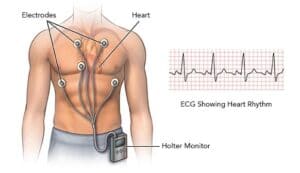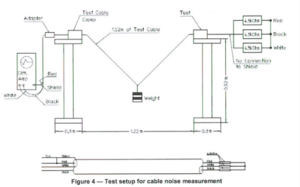MEDICAL CABLES AND WIRES: TRIBOELECTRIC NOISE
In vital signs monitoring, noise in a signal can make precise diagnosis problematic, sometimes impossible. Reducing sources of unwanted noise is a necessary requirement in ECG (electrocardiogram) cable design.

There are two main sources that generate noise into an ECG signal: external sources and the construction of the cable or leadwire itself. Noise generated from external sources is typically combatted by use of shielding within the cable. Noise generated internally within a cable may be referred to as handling noise or cable noise, but more accurately described as triboelectric noise.
Acknowledging that the amount of triboelectric noise in medical cables should be minimized, AAMI ANSI EC53 (ECG Trunk Cable and Patient Leadwires industry standard) requires the maximum peak-to-valley noise shall be less than 50 microvolts (µV).
WHAT IS TRIBOELECTRIC NOISE?
Triboelectric noise results when two dissimilar materials are rubbed together creating an electrical charge between them. This type of noise is generated by flexing or vibration of the cable or leadwire. Such movements result in friction between the cable’s conductors, insulation and fillers and can generate a surface charge resulting in triboelectric noise. The amount of charge generated is dependent on the arrangement and composition of the underlying materials and friction, or potential to build a charge between those materials. This can cause integrity issues with the acquired signal data.
Holding triboelectric noise to acceptable levels requires a thoughtful understanding of what the device can tolerate, careful material selection, design of construction, and processing as cable material is manufactured.
TRIBOELECTRIC NOISE TESTING
ANSI AAMI EC53, section 5.3.2 details the test methods for confirming triboelectric noise adequacy. Testing is always performed on the raw medical cable or wire material, not the finished medical device cable assemblies. The standard specifies to test a representative sample of material. The reason for this is to challenge the trunk cable and leadwire material and in order to do so, seven feet (7’) of material is required. Since most medical assemblies do not have an uninterrupted span of cable material beyond this required length, that is the reason why noise testing is performed on raw cable. This is common practice at ClearPath Medical.
TEST SETUP AND PROCEDURE

Figure 4 of the EC53 standard illustrates the test setup. A compliant set-up should be 36 inches high with heavy gauge steel posts mounted into a concrete or other sturdy floor set five feet apart, center-to-center. A one-half inch thick steel plate is centered on the top of each post allowing 5 feet of cable or wire to be held firmly between clamps set 48 inches apart. Care must be taken when setting up the test area, to ensure it’s away from interference with electrical panels, large electrical motors, vehicle traffic or foot traffic.
Attached at the center of the test unit is a weight that equals 40x the weight of one foot of cable or wire. When ready to test, a qualified test technician will hold the weight at the level of the clamps and drop the sample. The peak-to-valley voltage measurement is taken using a digital oscilloscope with pre-amplified signals. The resultant value must be less than 50µ volts.
DESIGNING TO REDUCE TRIBOELECTRIC NOISE
The more conductors and surrounding materials a medical cable may have, the greater the opportunity it has to generate triboelectric noise. It is often preferred to choose materials that glide on each other which will increase flexibility; however, care must be taken to select materials that when rubbed together do not produce unacceptable levels of noise.
Adding conductive materials and elements within the cable or wire that drain or dissipate the triboelectric charge away from the wire insulation can also reduce triboelectric noise.
In medical device applications where high sensitivity of signal to noise is needed, it is important to establish and document performance requirements at the development phase of the project. This ensures optimal success from project design to production.
SUMMARY
Post processing of ECG signals may be employed to filter and compensate for noisy signals but reducing noise at the source typically improves the diagnostic quality. Incorporating low-noise cable and wire materials and designing connectors and strain reliefs to prevent movement at terminations can help in reducing overall triboelectric noise.
Don’t let your questions get in the way of a great medical device design – connect with the team at ClearPath Medical for guidance on your application.

